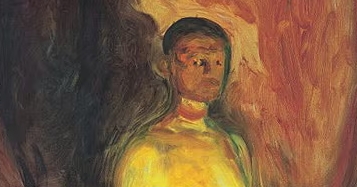Edvard Munch’s Self Portrait in Hell is a haunting and powerful piece of art that delves into the depths of the artist’s psyche. Let’s take a closer look at this dark and mysterious painting.
The Gaze of Despair
In this self portrait, Munch depicts himself with a look of despair and anguish on his face. His eyes seem to pierce through the viewer, conveying a sense of deep sorrow and suffering. The dark, shadowy background adds to the overall sense of foreboding and unease.
The Fiery Red
One of the most striking elements of the painting is the fiery red that dominates the composition. The red color symbolizes intense emotions such as anger, passion, and torment. It creates a sense of claustrophobia and suffocation, as if the figure is trapped in a hellish landscape.
Symbolism of Hell
The title of the painting, Self Portrait in Hell, suggests a descent into the darkest corners of the artist’s mind. Hell is often seen as a place of eternal suffering and punishment, and Munch’s self portrait seems to reflect his own personal demons and inner torment.
The Distorted Figure
Munch’s self portrait is not a literal representation of his physical appearance, but rather a distorted and exaggerated portrayal of his inner turmoil. The figure appears twisted and contorted, with exaggerated features that convey a sense of psychological distress.
The Legacy of Munch
Edvard Munch is known for his intense and emotionally charged artworks, and Self Portrait in Hell is no exception. This painting serves as a window into the artist’s tortured soul, allowing viewers to explore the darker aspects of the human experience.
In conclusion, Self Portrait in Hell is a haunting and evocative piece of art that invites viewers to explore the depths of despair and suffering. It serves as a powerful reminder of the enduring legacy of Edvard Munch and his ability to capture the complexities of the human psyche.



